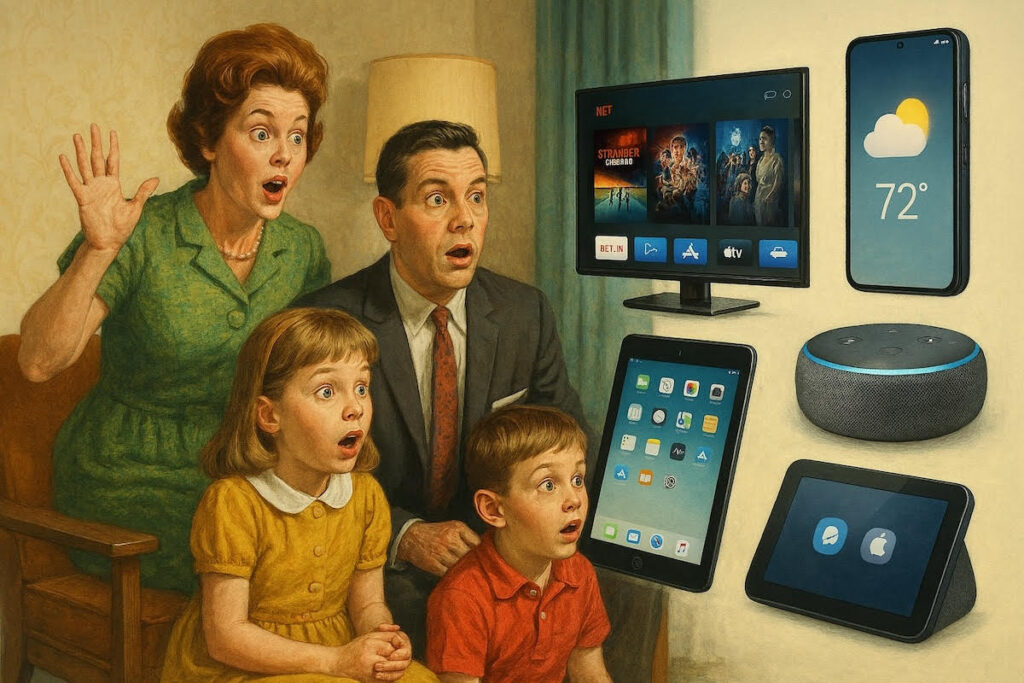The 1960s was the era of social change. New attitudes towards freedom, peace, and civil rights were paramount in many people’s minds. It was the decade of technological advances in household appliances, electronics, and media that changed lives for the better.
Sixty years later, those technologies appear in museums classified as antiques. The people of the 1960s would be stunned by the modern technologies we have today. How did it all come about? Pop culture hinted at the future.

Pop Culture
Movie and TV watchers and avid readers in the 1960s didn’t realize that they were privy to futuristic items that would become regular mainstays. They had no idea that the concepts featured in pop culture would be realities—in some cases, in under 10 years.
- The Jetsons: This 1962 animated TV show suggested that in the future we’d all communicate via video, be helped around the home by robots, and use voice-activated assistants. These are all standard household items today. The famous flying cars featured in the show are still years away, but they’re coming.
- Star Trek: Introduced the world to the idea of hand-held communicators, touchscreen computers, and universal translators. How soon until teleporting becomes a way of travel?
- The 21st Century: The March 1967 episode, titled “At Home, 2001,” of this documentary series narrated by Walter Cronkite suggested we’d all be living in smart homes complete with 3D television, inflatable furniture, robot servants, and automated kitchens where you’d find edible packaged food. Turns out, he was spot on.
- 2001: A Space Odyssey: Arthur C. Clarke’s 1968 novel is a futuristic look at space travel, with humans living on space stations and the AI computer taking over. Incidentally, the AI that eventually takes over is nicknamed HAL. Rumors abound that if you move one letter forward, you get IBM, which became the market leader in personal computers in the 1980s.
Modern Technologies We Take for Granted
Pop culture predicted them, and now they’re a reality. Here are four modern technologies that we have today that weren’t around in the 1960s, and how they’ve changed our behaviors.
Microwave Ovens
Preparing a meal for a 1960s family took between one and two hours, as the convection ovens of the era were slow cookers. Meals were mostly at set times, allowing for the cook to plan and prepare.
Those families had no idea that around 10 years later, microwave ovens would become standard kitchen appliances in many homes. What would take an hour or more to prepare could be delivered in around 15 minutes or less, making meals on the go more popular and sit-down dinners less common.
Digital Television
In the 1960s, televisions were chunky boxes with small screens averaging 19–21 inches. There was no remote control; people had to physically change the channel, and with only three channels, you watched whatever was on. Color TV was just being introduced, but the uptake was slow. Families would gather together in the living room to watch the news at 6 pm, followed by game shows, sitcoms, and later in the evening, westerns and dramas. If you weren’t home when the show you wanted to watch was screened, you would miss it and have to wait years for it to appear as a rerun.
Today, digital TVs deliver smart entertainment; they’re thin, with flat screens, and can be over 100 inches diagonally. They’re 100% under your control; you choose what and when to watch. You can pause it for bathroom or kitchen breaks, rewind, fast forward, or skip. Watching TV has become a more solitary activity. Streaming platforms offer multiple accounts, allowing anyone in the family to watch their own preferred content on whatever device they have. Streaming TV means never missing out on a show or movie, as it’s always available to watch somewhere.
Smartphones
While Star Trek and The Jetsons hinted at handheld communicators, the adoption of smartphones in the 1990s went considerably further. One device combines these common 1960s necessities: phone, calculator, camera, road maps, and a torch into one. These mini computers have changed society in so many ways, though not always for the better.
Families used to eat meals together and have face-to-face conversations. Little did they know that their future counterparts may still eat together, but there would be silence around the table as everyone has their heads buried in their smartphones.
Smartphones have revolutionized how we get our entertainment. For example, going out to the theater or a casino in the 1960s required dressing up in formal clothes and heading out. Today, you can stay at home in your underwear and stream movies on Netflix or visit online casinos that a site like BonusFinder advises.
Automobiles
The muscle cars of the 1960s were well-known gas-guzzlers, costing a fortune every time they went to the pumps. The biggest issue was the effect leaded gasoline had on the environment. The carbon monoxide that was emitted from car exhausts contained so much lead that the smog created caused serious health issues for many people. Ten years later, unleaded gasoline was invented, and while slightly more expensive at the time—around two cents per gallon—its positive effect on the environment was welcomed with open arms.
It wasn’t just the fuel that improved. Vehicles themselves were upgraded. Safety features like airbags and seatbelts were introduced, with more reliable, fuel-efficient engines. People of the 1960s would be stunned today to see electric cars, which totally eliminate the need for fossil fuels.
To the Future and Beyond
Ovens that could cook food in seconds, handheld phones, TV streaming on demand, and cars running on electricity—a person living in the 1960s would have laughed at all these ideas, dismissing them as science fiction. In 2025, however, these are all regular items that we don’t think twice about. Sixty years from now, what will people think about our “modern technologies?” They’ll likely be museum pieces by then.
